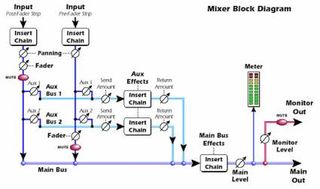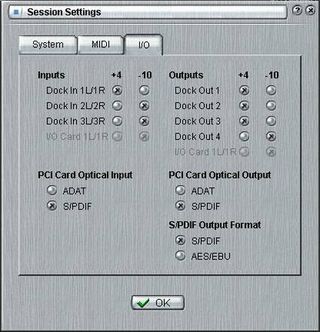Creative's E-MU 1820 Goes Home Studio Pro
A Digital Editing Desk And Much More!, Continued
We will not wax poetic on the output section, which is very simple with a single potentiometer, two VU meters, overload indicators and an inserts section. Naturally, there is an auxiliary section with send and return. There are also the standard editing desk features, using buses (a man bus and two auxiliaries).

It takes quite a while to configure Patchmix to your particular needs, at least if you want to take advantage of all the options. You can thus save these configurations which are known as "sessions."

You need to provide a certain number of settings for each session thus saved. This means that some work has to be done on the inputs and outputs. Each physical input and output can operate on two nominal levels of -10 dBV (mass market, "consumer") or +4 dBu (professional). For those who are not familiar with these technical concepts, the dBV is a unit based on 1 V (effective) while the dBu is a unit based on 0.775 V (effective). The letter "u" that follows the dB abbreviation indicates that this is an open (non-loaded) circuit, corresponding to standard audio use (in which a low-impedance output is loaded with a much higher impedance input). From this, it can be deduced that -10 dBV corresponds to 316 mV and +4 dBu to 1.23 V. These values have been rounded up.
We should emphasize that these are nominal levels and not maximum or peak levels. We will discuss this again in the section about the technical tests. In any case, the real level can change slightly depending on the impedance of the connection or connections. In practice, however, with standard equipment and normal use, there's nothing to worry about.

Nevertheless, you need to make the right choices for your session in order to optimize the levels. It would be a pity to use your E-MU card at any less than its maximum performance level. You should also remember that levels may change depending on whether you are using symmetrical or asymmetrical links.
Stay on the Cutting Edge
Join the experts who read Tom's Hardware for the inside track on enthusiast PC tech news — and have for over 25 years. We'll send breaking news and in-depth reviews of CPUs, GPUs, AI, maker hardware and more straight to your inbox.
Current page: A Digital Editing Desk And Much More!, Continued
Prev Page A Digital Editing Desk And Much More!, Continued Next Page Inserts And EffectsMost Popular

